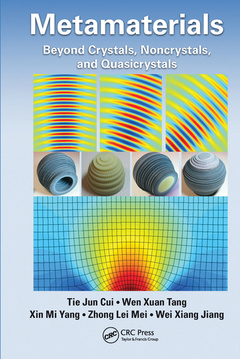Metamaterials Beyond Crystals, Noncrystals, and Quasicrystals
Auteurs : Cui Tie Jun, Tang Wen Xuan, Yang Xin Mi, Mei Zhong Lei, Jiang Wei Xiang

Metamaterials: Beyond Crystals, Noncrystals, and Quasicrystals is a comprehensive and updated research monograph that focuses on recent advances in metamaterials based on the effective medium theory in microwave frequencies. Most of these procedures were conducted in the State Key Laboratory of Millimeter Waves, Southeast University, China.
The book conveys the essential concept of metamaterials from the microcosmic structure to the macroscopic electromagnetic properties and helps readers quickly obtain needed skills in creating new devices at microwave frequencies using metamaterials. The authors present the latest progress on metamaterials and transformation optics and provide abundant examples of metamaterial-based devices accompanied with detailed procedures to simulate, fabricate, and measure them.
Comprised of ten chapters, the book comprehensively covers both the fundamentals and the applications of metamaterials. Along with an introduction to the subject, the first three chapters discuss effective medium theory and artificial particles. The next three chapters cover homogeneous metamaterials (super crystals), random metamaterials (super noncrystals), and inhomogeneous metamaterials (super quasicrystals). The final four chapters examine gradient-index inhomogeneous metamaterials, nearly isotropic inhomogeneous metamaterials, and anisotropic inhomogeneous metamaterials, after which the authors provide their conclusions and closing remarks. The book is completely self-contained, making it easy to follow.
Introduction. Effective Medium Theory. Artificial Particles. Homogeneous Metamaterials: Super Crystals. Random Metamaterials: Super Noncrystals. Inhomogeneous Metamaterials: Super Quasicrystals. Gradient-Index Inhomogeneous Metamaterials. Nearly Isotropic Inhomogeneous Metamaterials. Anisotropic Inhomogeneous Metamaterials. Conclusions and Remarks.
Tie Jun Cui is the full professor of the School of Information Science and Engineering, Southeast University, Nanjing, China, and associate director of the State Key Laboratory of Millimeter Waves. Since 2013, he has served as a representative of the People’s Congress of China. Dr. Cui earned his BSc, MSc, and PhD degrees in electrical engineering from Xidian University, Xi’an, China, in 1987, 1990, and 1993, respectively. He is coeditor of the book Metamaterials: Theory, Design, and Applications and the author of six book chapters. He haspublished over 350 peer-reviewed journal articles in Science, PNAS, Nature Communications, Physical Review Letters, Physical Review X, Advanced Materials, Light Science & Applications, and IEEE Transactions.
Wen Xuan Tang earned her bachelor’s degree in electronic engineering and her MSc degree in electromagnetic field and microwave technology from Southeast University, Nanjing, China, in 2006 and 2009, respectively, and her PhD degree in electromagnetics from Queen Mary University of London, London, United Kingdom, in 2012. In November 2012, she joined the School of Information Science and Engineering, Southeast University, Nanjing, China, as a lecturer. She has published over 20 technical articles in highly ranked journals, including IEEE Transactionson Antenna and Propagation, New Journal of Physics, Optics Express, AppliedPhysics Letters, and Scientific Reports.
Xin Mi Yang was born in Suzhou, Jiangsu Province, China, in March 1982. He earned his BS and PhD degrees from Southeast University, Nanjing, China, in 2005 and 2010, respectively, both in the School of Information Science and Engineering. Since November 2010, he has been with the School of Electronics and Information Engineering, Soochow University, Suzhou, China. His current research interests include metamaterials, metasurfaces,
Date de parution : 06-2020
15.6x23.4 cm
Date de parution : 06-2016
15.6x23.4 cm
Thèmes de Metamaterials :
Mots-clés :
Em Wave; IOP Publishing; Metamaterials; Full Wave Simulation Result; Transformation optics; Effective Medium Parameters; Metamaterial-based devices; Quasi-conformal Mapping; Metamaterial Unit Cells; Illusion Device; Luneburg Lens; Homogeneous Metamaterials; Invisibility Cloak; Lens Antenna; TL Metamaterials; Full Wave Simulations; Em Wave Incident; Effective Relative Permittivity; Metamaterial Slab; PEC Plate; CRLH TL; Left Handed Material; Resonant Particles; Gradient Index; Vivaldi Antenna; CST Microwave Studio; Refractive Index Profile; Backscattering Patterns



